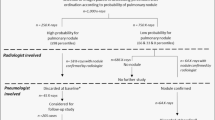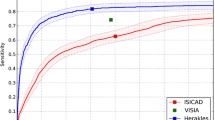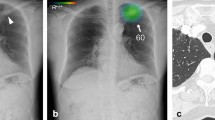Abstract
Background
Computer-aided detection (CAD) has been shown to increase the sensitivity for detection of pulmonary nodules in adults. This study reports initial findings utilizing a CAD system for the detection of pediatric pulmonary nodules.
Objective
To assess the performance of CAD and pediatric radiologists in the detection of pediatric pulmonary nodules.
Materials and methods
CT scans from a series of pediatric patients with known primary tumors and lung nodules were analyzed by four radiologists and a commercially available CAD system. IRB approval was obtained. Sensitivities were calculated for detection according to nodule size and location.
Results
In 24 children (age 3–18 years) 173 nodules were identified. Overall the sensitivity of CAD was 34%, but the sensitivity of CAD for detection of nodules 4.0 mm or larger was 80%. Overall radiologist sensitivity ranged from 68% to 79%. There were 0.9 CAD false-positives and 0.3–2.4 radiologist false-positives per study.
Conclusion
CAD in our pediatric oncology patients had good sensitivity for detection of lung nodules 4 mm and larger with a low number of false-positives. However, the sensitivity was considerably less for nodules smaller than 4 mm.





Similar content being viewed by others
References
Davis SD (1991) CT evaluation for pulmonary metastases in patients with extrathoracic malignancy. Radiology 180:1–12
Peldschus K, Herzog P, Wood SA et al (2005) Computer-aided diagnosis as a second reader: spectrum of findings in CT studies of the chest interpreted as normal. Chest 128:1517–1523
Yuan R, Vos PM, Cooperberg PL (2006) Computer-aided detection in screening CT for pulmonary nodules. AJR 186:1280–1287
Rao JN, Scott AJ (1992) A simple method for the analysis of clustered binary data. Biometrics 48:577–585
McCarville MB, Lederman HM, Santana VM et al (2006) Distinguishing benign from malignant pulmonary nodules with helical chest CT in children with malignant solid tumors. Radiology 239:514–520
Crow J, Slavin G, Kreel L (1981) Pulmonary metastasis: a pathologic and radiologic study. Cancer 47:2595–2602
Spencer H (1985) Pathology of the lung, 4th edn. Pergamon, Oxford, pp 1085–1096
Muller KM, Respondek M (1990) Pulmonary metastases: pathologic anatomy. Lung 168(Suppl):1137–1144
Scholten ET, Kreel L (1977) Distribution of lung metastases in the axial plane. Radiol Clin (Basel) 46:248–265
Murata K, Takahashi M, Mori M et al (1992) Pulmonary metastatic nodules: CT-pathologic correlation. Radiology 182:331–335
Awai K, Murao K, Ozawa A et al (2004) Pulmonary nodules at chest CT: effect of computer-aided diagnosis on radiologists’ detection performance. Radiology 230:347–352
Das M, Mühlenbruch G, Mahnken AH et al (2006) Small pulmonary nodules: effect of two computer-aided detection systems on radiologist performance. Radiology 241:564–571
Marten K, Seyfarth T, Auer F et al (2004) Computer-assisted detection of pulmonary nodules: performance evaluation of an expert knowledge-based detection system in consensus reading with experienced and inexperienced chest radiologists. Eur Radiol 14:1930–1938
Marten K, Grillhösl A, Seyfarth T et al (2005) Computer-assisted detection of pulmonary nodules: evaluation of diagnostic performance using an expert knowledge-based detection system with variable reconstruction slice thickness settings. Eur Radiol 15:203–212
Beyer F, Zierott L, Fallenberg EM et al (2007) Comparison of sensitivity and reading time for the use of computer-aided detection (CAD) of pulmonary nodules at MDCT as concurrent or second reader. Eur Radiol 17:2941–2947
Rubin GD, Lyo JK, Paik DS et al (2005) Pulmonary nodules on multi-detector row CT scans: performance comparison of radiologists and computer-aided detection. Radiology 234:274–283
Wilimas JA, Kaste SC, Kauffman WM et al (1997) Use of chest computed tomography in the staging of pediatric Wilms’ tumor: interobserver variability and prognostic significance. J Clin Oncol 15:2631–2635
Naidich DP, Rusinek H, McGuiness G et al (1993) Variables affecting pulmonary nodule detection with computed tomography: evaluation with three-dimensional computer simulation. J Thorac Imaging 8:291–299
Rusinek H, Naidich DP, McGuinness G et al (1988) Pulmonary nodule detection: low-dose versus conventional CT. Radiology 209:243–249
Robertson PL, Boldt DW, De Campo JF (1988) Paediatric pulmonary nodules: a comparison of computed tomography, thoracotomy findings and histology. Clin Radiol 39:607–610
Author information
Authors and Affiliations
Corresponding author
Rights and permissions
About this article
Cite this article
Helm, E.J., Silva, C.T., Roberts, H.C. et al. Computer-aided detection for the identification of pulmonary nodules in pediatric oncology patients: initial experience. Pediatr Radiol 39, 685–693 (2009). https://doi.org/10.1007/s00247-009-1259-9
Received:
Revised:
Accepted:
Published:
Issue Date:
DOI: https://doi.org/10.1007/s00247-009-1259-9




